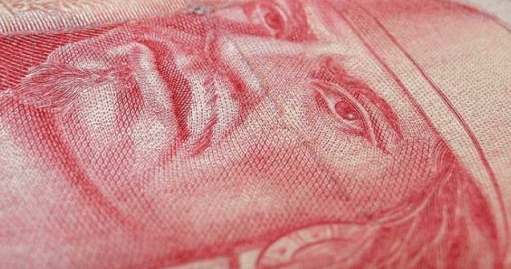The peso starts the session with a depreciation of 0.29% or 5.9 cents, trading around 19.97 pesos per dollar, with the exchange rate touching a minimum of 19.8695 and a maximum of 19.9769 pesos, in view of the expectation that the accelerated economic recovery may cause the Federal Reserve to adopt less flexible language in the coming months.
It should be remembered that just yesterday in his monetary policy announcement, it was highlighted that the US economy is recovering at a solid pace and at night, Joe Biden said that the country has left the pandemic behind, but reiterated the need to increase taxes on the highest income population.
This has pushed up the interest rate on 10-year Treasury bonds, which rises 5 basis points to 1.66%, accumulating an increase of 10 basis points in the week.
The rate move is set to become the largest weekly increase since the first week of March.
The peso
In the United States, GDP grew at an annualized quarterly rate of 6.4% during the first quarter of the year, which is equivalent to a quarterly rate of 1.6%, which should be used to facilitate comparison with the growth data of the Mexican economy that is reported. they post tomorrow.
At an annual rate, GDP grew 0.4%, the first annual increase after registering three consecutive quarters of falls.
The economic recovery of the United States was driven by 1) the fiscal stimuli approved since last year and in recent months that have represented 27% of the United States GDP in 2020, 2) the implementation of a broadly flexible monetary stance since March 2020 and 3) the progress of the vaccination campaign against Covid19, since in the country 43% of the population has received at least 1 dose.
Thus, GDP is only 0.86% below the pre-pandemic level (4Q 2019).
Investment
By component, consumption represented 7.02 percentage points of the 6.40 points of annualized quarterly growth, while government spending added 1.12 points.
For its part, investment subtracted 0.87 points and net exports also subtracted 0.87 points from GDP in the fourth quarter.
Going forward, the US economy is expected to show a full recovery in the second quarter of the year, which would mean it will take five quarters to recover, well below the 15-quarter period it took to recover during the last crisis (from 4Q2007 to 3Q2011). .
Towards the end of 2021, the GDP of the United States is estimated to show an average growth of 6.2% in the year.
Laboral sector
The weekly employment report was also published in the United States, which showed that initial applications for unemployment support decreased by 13 thousand compared to the previous week, reaching 553 thousand units, spinning three consecutive setbacks.
On the other hand, continuous applications for unemployment support, from those people who already received support or who continue to wait for, rose from 3.65 to 3.66 million, the first weekly increase since January.
Peso and oil
In the raw materials market, prices continue to rise, with energy standing out.
The WTI starts with an advance of 1.47%, trading at 64.8 dollars per barrel accumulating a weekly increase of 5.49%, while natural gas rises 2.76%, accumulating a weekly increase of 7.06 percent.
However, only some currencies of commodity-producing countries have been favored, such as the Canadian dollar that advanced 0.27%, the Russian ruble with 0.20% and the Norwegian krone with 0.20 percent.
GDP
Regarding economic indicators in Mexico, in 2020 the Quarterly Indicator of State Economic Activity (ITAEE) showed an average annual decline in economic activity in 31 of the 32 states.
The states with the largest contractions on average were: Quintana Roo (-24.25%), Baja California Sur (-21.12%), Puebla (-11.62%) and Tlaxcala (-11.55%), the largest drop is observed in the states whose activity economic depends mainly on the tourism sector.
While the states that showed the lowest average annual falls were: Chiapas (-4.15%), Zacatecas (-4.3%), Baja California (-4.42%), Oaxaca (-5.32%) and Chihuahua (-5.9%). The only entity that showed annual growth was Tabasco (3 percent).
During the fourth quarter of 2020, there was a slight improvement in the country’s economy, which was reflected in quarterly growth in practically all the states.
The indicator showed quarterly growth in 31 of the 32 states.
The most significant quarterly growths were observed in: Quintana Roo (9.7%) and Baja California (9%), due to the fact that economic activity began to reactivate. It should be remembered that these states were the most affected by Covid and have begun to show rebounds, due to the low base of comparison. The quarterly fall in the state of Tlaxcala (-0.2 percent) stands out.
The main states of the country, which represent more than 30% of Mexico’s GDP, showed moderate quarterly growth, Mexico City (1.7%), Jalisco (3.4%) and Nuevo León (3.9 percent).
During the session, the exchange rate is expected to trade between 19.90 and 20.10 pesos per dollar.
The euro starts the session with an appreciation of 0.04%, trading at 1.2131 dollars per euro, while the pound gains 0.18% and is trading at 1.3960 dollars per pound.
Money market and debt
In the United States, the yield on the 10-year Treasury bonds increases by 4.5 basis points, to 1.65%, while in Mexico the yield on the 10-year M bonds increases by 1.5 basis points, at a rate of 6.86 percent .
Derivatives market and the peso
To hedge against a depreciation of the peso beyond 20.50 pesos per dollar, a purchase option (call), with an exercise date within 1 month has a premium of 1.24% and represents the right but not the obligation to buy dollars in the aforementioned level.
On the other hand, the interbank forward for sale is at 20.0385 at 1 month, 20.3984 at 6 months and 20.8686 pesos per dollar at one year.
Gabriela Siller; PhD
Director of Economic-Financial Analysis.
Banco BASE
![]()

